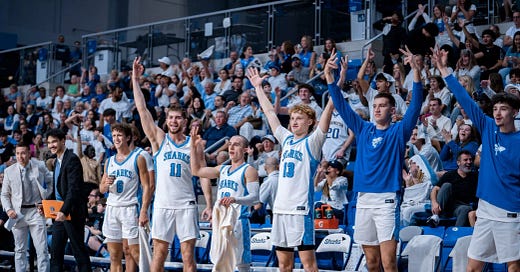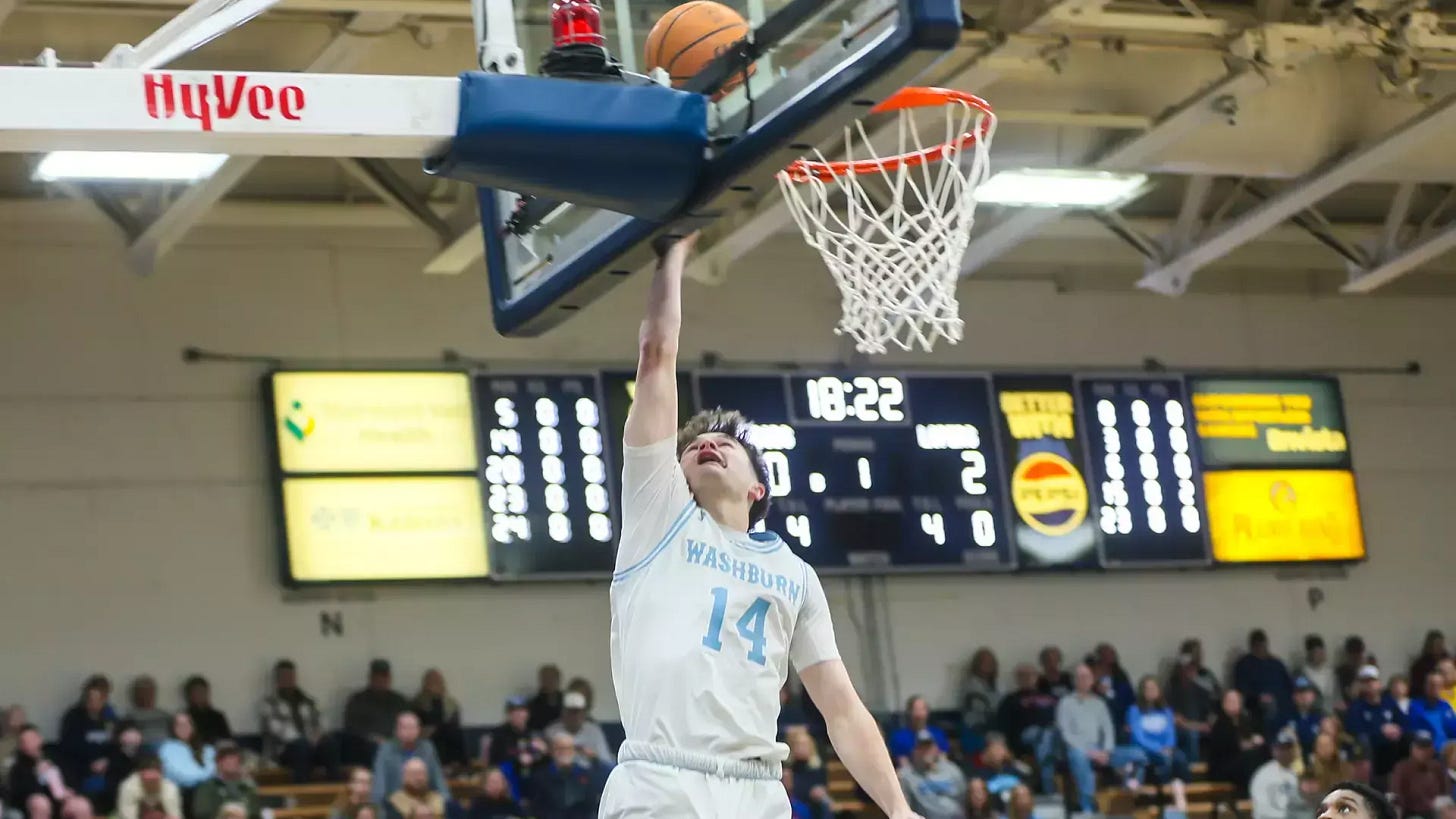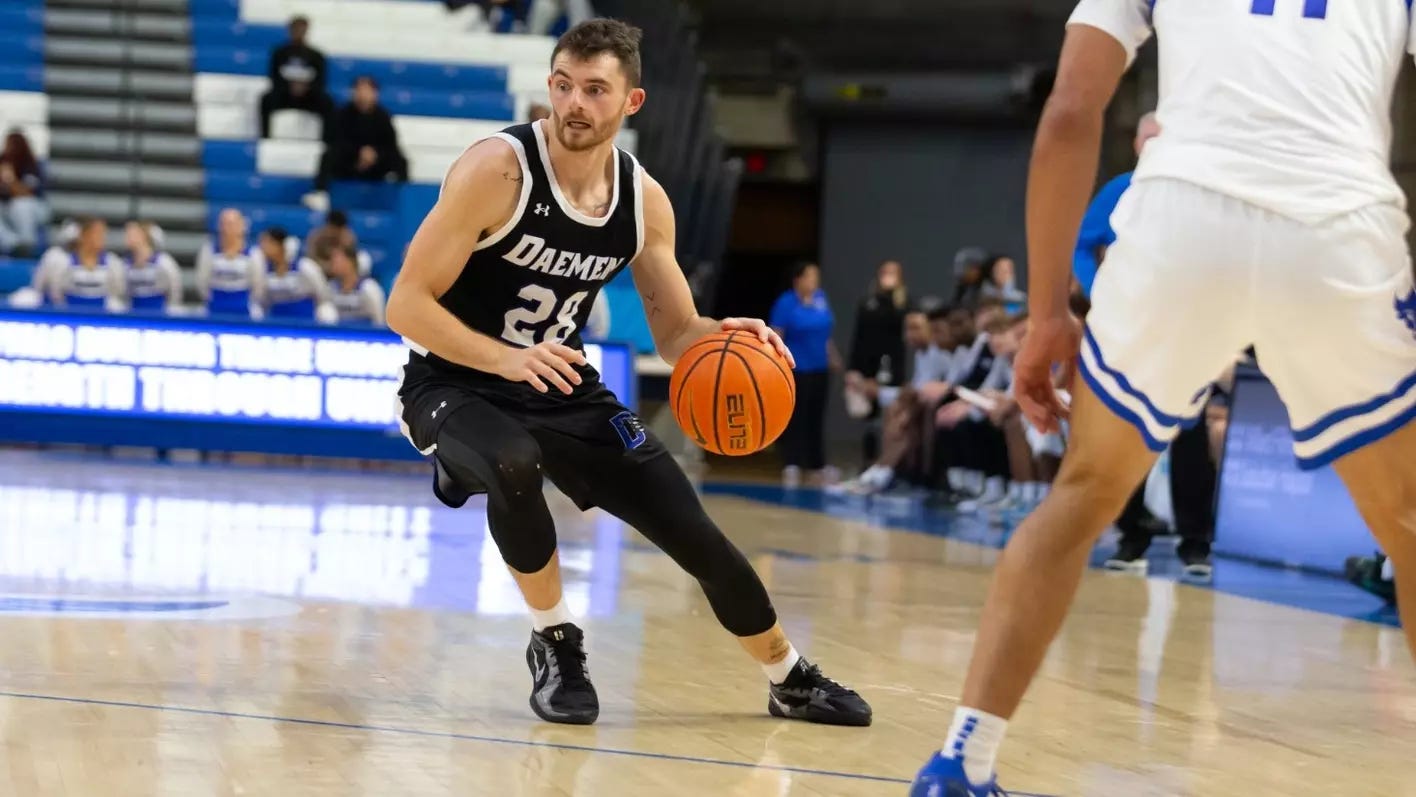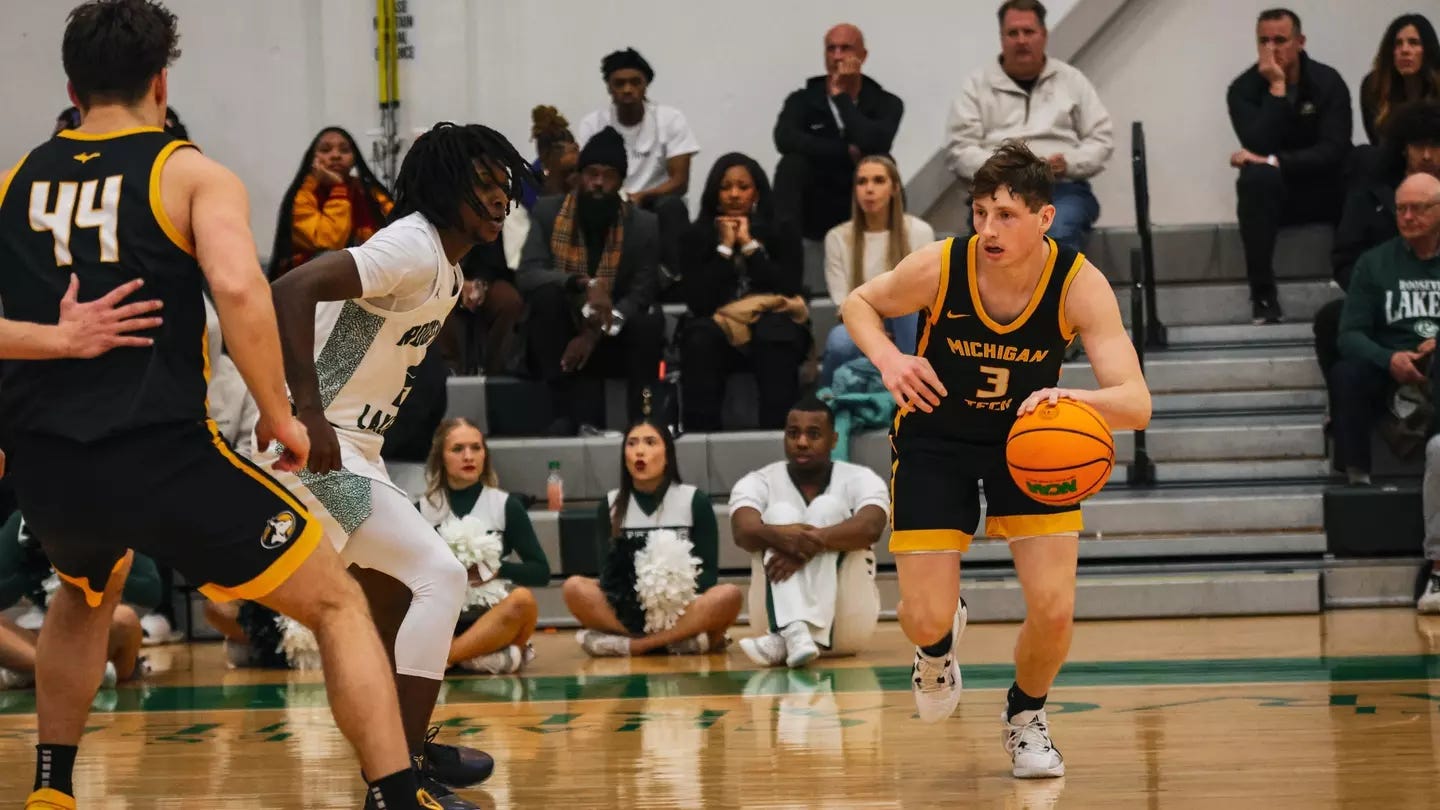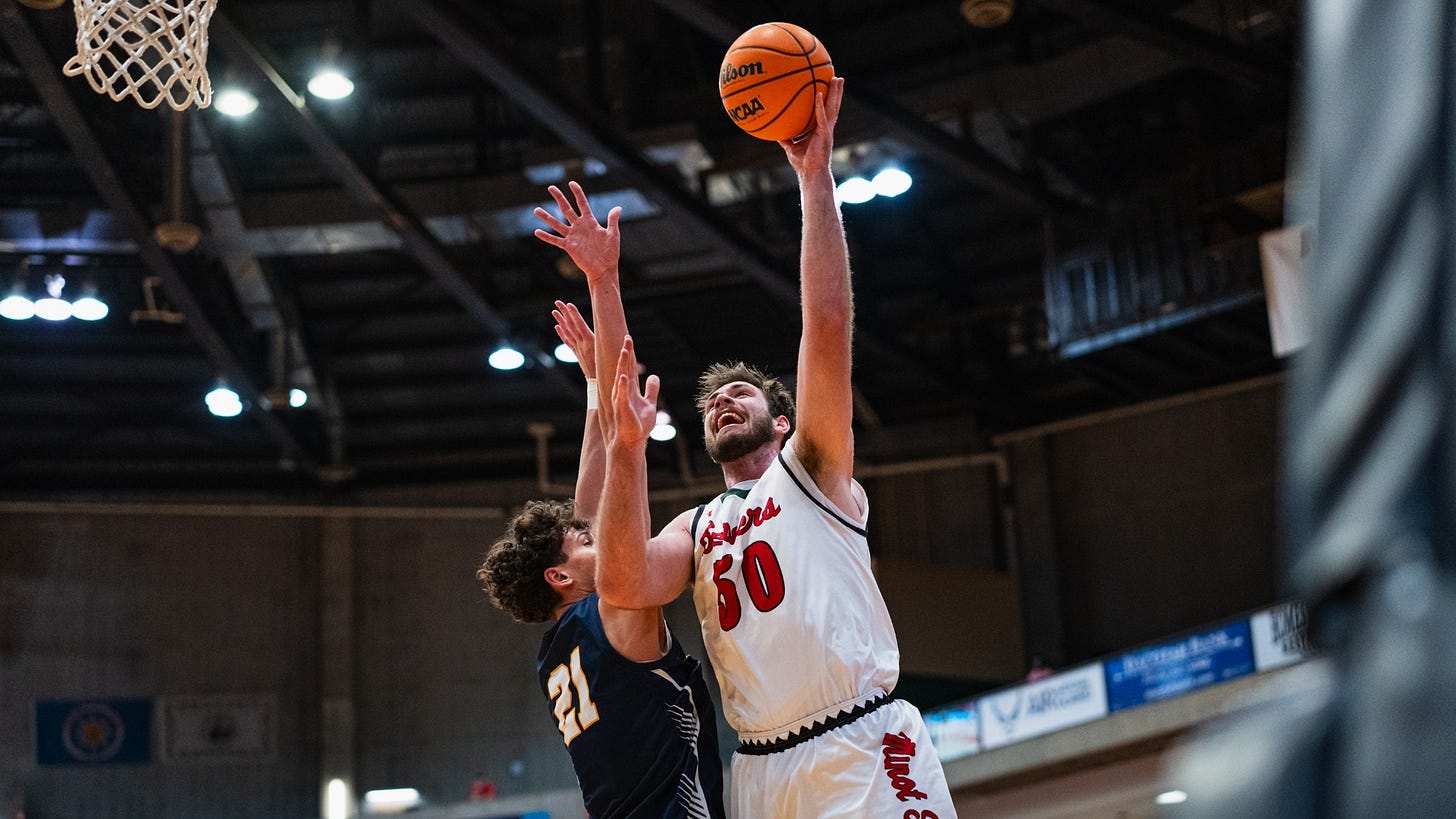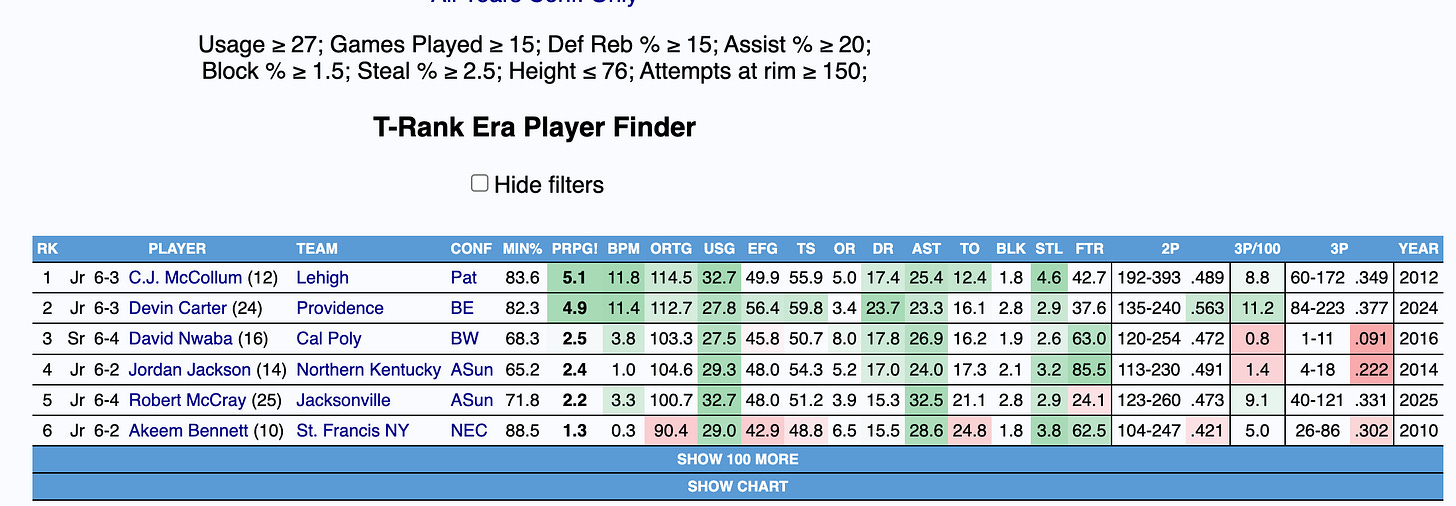The Division II catchup: favorites, challengers, darkhorses, and key players
5,500+ words of information about a different NCAA Tournament
This is almost certainly too long for email, so click through to the website to read in full. -WW
While I figure you all know more than enough about the Division I race this year, there are other divisions within the NCAA structure. There are two more of them! It’s true. Every year, while March Madness rages on, other lesser-known March Madnesses rage on in smaller arenas across America. Division II is the most well-known for obvious reasons, but mostly because it’s the next-best thing out there.
Plus, D2 has proven itself as extremely influential in its own right. The Northwest Missouri State program that won four titles in six years (and very well could’ve won a fifth in 2020) now has its architect running Drake, arguably D1’s best mid-major. Five champions from the last 30 years (CSU Bakersfield, Southern Indiana, UC Davis, Kennesaw State, and Bellarmine) are now Division I teams. Plus, the basketball in its own right is different and differently influential than D1. The last two title games have ended with scores of 111-101 and 88-85…in regulation!
So: as an educational piece for you and for me, I thought it would be fun to spend a day breaking down this particular season of D2 hoops. Who are this year’s favorites to bring home the title? Who are the challengers? Who are the players you should be aware of? What about rising underclassmen? Younger coaches on the rise? I’ve tried to cover as much as I can here without going overboard.
TITLE FAVORITES
In six out of 10 simulations, one of these two teams is your national champion.
Normally, the D2 title race is actually a little less open for challengers. From 2017 through 2022, Northwest Missouri more or less dominated this level like the D2 MBB version of North Dakota State football. They won four out of a possible five titles, and even in the year they didn’t win one (2018), they went 27-4. Even in 2023, when Nova Southeastern beat out West Liberty for the title, they were rated nearly five points per 100 possessions clear of the next-best challenger.
Last year, this changed. All of Nova Southeastern, Northwest Missouri, Minnesota State, West Texas A&M, and Minnesota-Duluth entered March as roughly equal teams. The final between Nova and Minnesota State was an instant classic, but it was just the continuation of a phenomenal year of D2 hoops. West Texas A&M, who Minnesota State edged out in the national semifinal, just as easily could’ve been there themselves.
This year, there’s a clear top two that have separated themselves somewhat from the field: Nova Southeastern, the perennial challenger, and Washburn, the new kids on the block from Northwest Missouri’s conference. (You won’t see Northwest Missouri in this year’s tournament, by the way. The first post-McCollum season has been disastrous.) While others are on the edge of joining the fray, these two have led the pack for over three months and rate in the top three of every D2 metric available.
Nova is the clear leader, though. At 25-1, with the one loss being 87-84 on the road to Palm Beach Atlantic in a game where they posted their worst 3PT% of the season (25.9%), they’re as close to unassailable as one can get this season. By CBB Analytics’ numbers, they’re #1 overall, #1 offensively, #4 defensively, and rate out four points better than they did in 2023 when they won the title.
While every Nova team is built on fast breaks, running up huge turnover/rebound margins, and generating far more shot attempts than the opponent, this year’s group differentiates themselves from 2023 in a couple of key areas. For one, they move the ball better than ever, with a 62% Assist%. In another, they’re actually much less reliant on threes than you may expect. The Nova system generates a lot of transition play, but point guard Dallas Graziani oversees half-court sets with tons of off-ball cuts and movement. His 6.2:1 A:TO ratio is, uh, nuts.
Every member of the Nova roster can hit threes, but it isn’t really their first goal; only about 31% of Nova SE shots are from deep. Instead, it’s a roster full of guards, wings, and the occasional big that can score anywhere from 0-25 feet, pass to anyone, drive from anywhere, and creates havoc and bad matchups all over the court. They are an utter delight to watch play this sport.
If the title favorite doesn’t take it, the next suspect in line is Washburn, who is putting together a dream season behind a rising coach in Brett Ballard. Ballard was the video coordinator for the 2007-08 Kansas Jayhawks, who you may remember as being that year’s champion. In year eight as a head coach (and year one post-McCollum in the MIAA), Ballard’s finally breaking out with the best team Washburn has had in 20+ years, if not school history.
Washburn is less explosive than Nova Southeastern but still quite well-rounded; CBB Analytics has them with D2’s second-best offense and 11th-best defense. With the ball in their hands, the Ichabods offer a unique two-pronged attack: one through lots of 1-5 P&Rs that get their guards downhill, one that operates through the post. Both involve lone starting forward Andrew Orr, a 6’8” big that has been tremendous with the ball in his hands and leads the team in Usage% while playing barely 23 minutes a night.
The P&R is much more common, however, and a litany of guards get to handle the ball in Washburn’s 4-out offense. Sophomore point guard Jack Bachelor is my single favorite of the group; his 2.8 A:TO ratio and serious plus shooting ability are pretty notable. Teams can’t play drop against him because he’s a 40% shooter off the dribble, but they can’t ice or blitz him because he’s excellent at getting the ball out quick to Orr or another screener.
Defensively, they’re also stout, though not as excellent as the offense. Ballard’s group blitzes ball screens pretty hard and rarely lets the ball handler get off easy shots; they’ve allowed the fewest points per possession to ball handlers in a pick-and-roll in D2. They also force more 1-on-1 possessions than 98% of their D2 contemporaries. Look, it’s not my job to be athletic director, but if I was, I’d be fairly interested in Brett Ballard for a Horizon/MVC/Summit League job.
These are the two best teams. What about the next-best group?
TITLE CHALLENGERS
In 3.5 out of 10 simulations, your champion comes from this group.
While the nation is ruled by the top two of Nova Southeastern and Washburn, there’s some really strong next-best teams that will have something to say once the Tournament begins. If any one of these teams is your future champion, it wouldn’t really be that much of a shocker.
The third-best team in D2, which is simultaneously the last undefeated team, is Daemen. The Wildcats are 24-0, have the nation’s best defense, are +12.7 on the offensive boards per 100 possessions, and are nearly +20% in 2PT%. Also, while I do not care about polls ever, they’re #1 in the D2 polls. So: what gives? Why aren’t they in the top group with Nova Southeastern and Washburn?
The answer for Daemen is a fairly easy one: we can’t yet trust them because of a very, very weak conference. Seven of their eight East Coast Conference counterparts have won 38% or fewer of their games this season. The one decent team, Thomas Aquinas, is 20-8…and lost to Nova Southeastern and Daemen across three combined games by a total scoring margin of -75. It’s like going undefeated in the Summit League: impressive, yes, but to a fault. Daemen owns one win over a top-75 team (#38 Gannon, 82-70) all season. Still, they’re a fun watch and offer a wonky matchup zone defense that forces the second-most midrange jumpers in D2.
While it’s a tight group I’d probably have Alabama Huntsville next up, who suffer from a somewhat similar affliction as Daemen, though their conference (Gulf South) is more Missouri Valley than Summit. Huntsville, under new HC Mick Hedgepeth - yes, the same Mick Hedgepeth of Belmont in the late 2000s/early 2010s - plays a style of mathball that is simply beautiful to the Excel-trained eye.
The upside of Huntsville is that. The downside: their defense is pretty forgettable, sitting 57th-best nationally and a likely Achilles heel to a championship chase. Their style of mathball extends to defense, where they run one of the deepest drop coverages in D2. This means the lowest amount of fouls committed in D1…but also the sixth-lowest amount of turnovers forced, too. Very fun team with a 35-year-old HC that I imagine you’ll be hearing a lot more from soon.
While there’s a fair few picks here for fifth I’m rolling with Colorado School of Mines, who seems to constantly exist in this space of being excellent but not elite. There are worse ways to live. Mines is 23-3 and two of their three losses are to teams in this article, neither of which are bad losses to take. For the 24th straight year, Pryor Orser is in charge of the Orediggers, who offer the same formula they usually do: elite offense, fairly good defense, a deep bench, and a roster where everyone can score, headlined by the wonderfully-named Majok Deng (14.8 PPG, 55% 2PT, 34% 3PT).
Massey believes this is the second-best team in Mines history behind 2022-23, a 26-6 group. Yet that group flopped in the first round, as did 2023-24. In fact, the deepest they’ve gone is D2’s equivalent of the Sweet Sixteen. Why? For one, Mines isn’t elite in shot volume prevention or production, meaning that on off-nights, they may not be able to find enough points to overcome it. The other: their interior defense is frankly pretty weak. Still, when you shoot as well as these guys do, you’re always in the hunt.
After great deliberation among three teams that are basically equal, I landed on Minnesota-Duluth for what we’re calling sixth. At first glance, it might be confusing. Duluth’s offense doesn’t even rank inside the top 60 nationally, and their best feature is probably getting fouls a lot. But: they have a top-3 defense, are one of the sport’s best rebounding teams, and are among the very best in rim protection.
What Duluth lacks offensively - and boy, do they - they really make up for it on the other end. A pace of 70.1 possessions a game belies an opponent offensive pace that sits in the 280s nationally (out of 300). A roster that’s unusually heavy on forwards (four of their top five players in minutes are 6’6” or taller, all listed as SFs or PFs) creates a lot of switchability on defense, which leads to long, dull possessions for opponents. It isn’t sexy, but to the tune of 20-8 this year and top 10 rankings at most sites, it’s worked.
Beyond them are two super-fun teams: Lincoln Memorial and West Liberty. They’re pretty similar and I don’t feel particularly strongly about one being in front of the other, so as a compromise, they’re both here.
The Railsplitters, coached by Josh Schertz understudy Jeremiah Samarrippas, do most of the things that made the original Schertz-era LMU so fun: an extreme focus on attacking the rim, a relentless transition attack that stresses defenses, and a surprisingly good defense that controls the boards while forcing a lot of tough twos. They play surprisingly slow compared to a Schertz team, but still generate lots of fastbreak points. The opponents who’ve beaten them all had one thing in common: they were patient and were able to beat LMU’s defense in the paint via downhill drives.
West Liberty, meanwhile, is still coached by Ben Howlett somehow. I figured Howlett would have a D1 job by now, but here we are. The sales pitch of West Liberty is that it’s Nova Southeastern, because Nova Southeastern HC built West Liberty’s program and handpicked Howlett to succeed him. So: heavy press, a huge turnover margin in their favor every game, and a goal of getting 10+ more field goal attempts than the opponent every time out. When it works, it’s beautiful. When it doesn’t, they can give up 100 in regulation, which they’ve done three times this season.
ELITE EIGHT HOPEFULS
There’s a…I don’t know, 5% chance? your future champion is among this group. Maybe.
Considering everyone in this group is roughly equal, with a CBB Analytics difference of five points per 100 possessions among the best and worst of these 16 teams, I don’t deem it necessary to differentiate by a ranking of any sort. Instead, we’ll go in alphabetical order.
Adelphi, of the Northeast 10 (yes, a real conference) carries strong ‘ain’t played nobody’ vibes to it. But! They have played fellow NE10 competition Pace twice, a team CBB Analytics has in its top 15, and beat them both times. They own a 6-3 record against top-100 competition. The Panthers have D2’s 12th-best defense and have more of an Auburn style of defense, in that they funnel a lot of offensive actions to the rim, where they’re allowing a 51.8% hit rate. 6’8” senior Jamel Rancy is an unbelievable defender, blocking 3.5 shots a game.
Of this next-up group, Dallas Baptist is likely the best. The Patriots have D2’s 8th-best defense, per CBB Analytics, and are #1 by a mile in turnovers forced. Their full-court press can be a brutal one to break, and all four losses they’ve taken are understandable. Their problem is what happens when they don’t force turnovers offensively. Possessions starting from a live turnover generate 1.25 PPP; all other possessions combined generate 1.07 PPP. Star guard Ricky Lujan is the one plus shot maker on the roster.
East Stroudsburg is generically all-around good, but they thrive in pure shot volume margin more than anywhere else. On average, they generate 6.7 more offensive rebounds per 100 attempts and win the turnover battle by 5.1 per 100 possessions. That’s a heck of a combo, particularly when you are horrendous at rim protection due to a full-court press that frequently leaves the basket uncovered. Fun but chaotic. Perhaps recommended if you like the Lady Vols?
Ferris State won the national title in 2018, the only non-Northwest Missouri champion from 2017 through 2022. How’d they do it? The same way they generally run through the GLIAC: excellent ball movement, strong interior defend, and an unusually tough-to-break press defense that causes nightmares for some opponents.
If you like Nova Southeastern and West Liberty, you’ll like Gannon, who is coached by Easton Bazzoli. Besides the amazing name, Bazzoli is a former Jordan Fee assistant, who himself was a former Jim Crutchfield assistant. Only two teams in the nation attempt more field goals per game than Gannon, and only Nova Southeastern plays faster. The problem for Gannon, who is 21-6, is that they’re not nearly as efficient as the best versions of this style are; they shoot 51% from two and 34% from three. Still, a fun system.
Besides being in the very best part of America, Lake Superior State is also very good at basketball this year. A consensus top-12 team, LSSU is excellent on both ends of the court, but is particularly potent from deep. They’re shooting 37.6% from three on over 26 attempts a game. Seven times this year, they’ve made 13+ in a game. Such a 3PT-heavy style leads to predictable results. The Lakers are 14-0 when shooting 40% or better from deep…and 9-5 when under that, including 5-4 when 33% or worse.
I really enjoy this Lubbock Christian team, who has what feels like a star in the making in sophomore Ethan Duncan. At just 6’0”, Duncan is certainly smaller, but his shooting is nuts. He’s knocking down 42% of his threes on nearly 7 attempts a game, shoots 93% at the line, and makes Lubbock’s offense (already one of the 10-15 best) nearly 10 points better per 100 when he’s on the court. Lubbock’s downfall when it happens will be a fairly middling defense that gives up a lot of paint points, and their uber-slow style (64 possessions a game) is susceptible to upsets, but Duncan is worth tracking.
At 17-7, we normally wouldn’t think much of the Lynn Fighting Knights, but they offer two things that fascinate me for March. For one, they take the most threes in the sport, sitting at 36 attempts per game. They have the lowest turnover percentage, a 96th-percentile Assist Rate, and even play reasonably good defense. Why don’t I fully believe in them? Well, they’re the third-best team in their own conference, and they come out as a consensus top-30 team, not a top-10 one. Still very salty.
Michigan Tech: perennially very good, if not often great. Six times in the last 11 full seasons, they’ve finished with between 7 and 9 losses. You know this year’s group because they upset Green Bay earlier in the season, but they’re sort of their usual selves: routinely good on both offense and defense, taking a ton of threes, and spacing the floor on both ends. Their fate entirely depends on their shooting. They’re 16-1 this year when shooting 37% or better from deep…and 4-5 otherwise. Against Green Bay, they shot 37%.
Midwestern State is not in the Midwest, but rather in Texas. It’s in Wichita Falls and Dr. Phil went there. Seriously! Playing in a top-five conference in D2 (Lone Star), the other MSU plays a very deliberate style predicated on excellent defense and turnover prevention. They’re also littered with fantastic shooters, shooting 39% from deep as a team. The offense comes and goes, but guards Pierre Sanders and Mason Gibson have combined to shoot 44.4% from deep this year on 185 attempts. In fact, the Mustangs have SIX GUYS that shoot 38% or better from deep in their rotation. Scary team when they’re hitting.
Missouri S&T is a blast. They had a pair of exhibitions against D-1 competition this year. One went really well, taking Tulsa to overtime on the road. The other, a 22-point road loss to Southern Illinois, not so well. Still, both perfectly reasonable outings for any D2 team to have. They’re also in the midst of easily, easily their best season in 30 years. S&T didn’t finish .500 at any point from 2005 through 2022. This year, the Miners are 22-3 (16-2 GLVC) thanks in part to having one of the best players in D2 on their roster. Andrew Young (18.5 PPG, 8.8 RPG, 63% 2PT, 37% 3PT) is an outright star who plays in the mold of an Evan Mobley.
Moorhead State was last year’s main villain (of sorts) for Minnesota State. This year, with Minnesota State taking a step back, Moorhead has emerged as part of a six-team second class in the NSIC with Duluth as the head of the snake. Moorhead’s offense remains very good, but their defense is almost conservative to a fault, turning up the dial on rim denial and packing it in. That means a lot of deeper shots, but a lot of room for shooting variance and very few forced turnovers. A team that feels very top 20-25, but not top 10.
I really enjoy this Pace team, who is in a weak NE10 but has been a top-40 team in every metric for most of the season and who CBB Analytics really likes. The Setters (yep) take far more midrange twos than you’re supposed to, and I cannot proclaim to believe much in their offense. But this is a top-3 defense in D2, one that is holding opponents to 47% on twos and 28% on threes. They forced a lot of turnovers, protect the paint well, and do pretty much everything well aside from fouling. Really, really tough out.
When I went to the 2019 D2 title game, Northwest Missouri’s opponent was Point Loma, who now has a new coach in Justin Downer. The Sea Lions play a true 5-out where the main lineup features no one taller than 6’6” Luke Haupt. The most fun piece is easily senior guard Zack Paulsen, he of 16.8 PPG, 58% 2PT%, and 45% 3PT. This style produces very few non-rim twos and a lot of great shots, but unsurprisingly, opponents don’t take many threes because they can usually get to the paint. They’re probably the best team on the West Coast this year.
Our 15th and final team here is Southwest Minnesota State, the second-best team in the NSIC this year and arguably its most well-rounded group. SMSU commits the fewest fouls in the conference by far (just 12.6 per 40 minutes), yet still manages a high Steal% (11.7%) and Block% (8.9%), which demonstrates a remarkable ability to create havoc without going overboard. Thanks to their status, they’ve played 10 of their 28 games against top-25 teams this year and have gone 7-3. The offensive side of things can be touch-and-go but is largely fine.
POTENTIAL DARKHORSES WITH ELITE OFFENSES OR DEFENSES, BUT NOT BOTH
It does what it says on the tin. I don’t think these teams can sustain it for six games let alone three, but every year there’s a surprising Elite Eight team that beats my expectations.
Valdosta State is #1 in the nation in percentage of points from the fastbreak (27%) and averages 92.7 PPG a night. The downside: they’ve given up 96+ points five times this year and Alabama Huntsville swept them by a total of 23 points.
Minot State has D2’s best player in junior Caleb Van De Griend and went 5-4 against top-25 teams this year thanks to the 14th-best offense in D2. Yet they still have eight losses overall thanks to the 179th-best defense. This is D2’s Iowa, or perhaps a Utah State.
Fairmont State is another team with a fantastic offense and a very middling defense. They’re 22-4 but play in a fairly pedestrian Mountain East, which has West Liberty, Fairmont, and…not much else. The MEC is rated as the 17th-best D2 conference out of 24.
Bentley has a similar issue: they’re in the middling ME10, but they have an electrifying offense to pair with one of the worst defenses you may see all season. I love them.
Concordia-St. Paul has Antwan Kimmons, who is a phenomenal basketball player, and is a dominant team on the interior. They’re also an elite rebounding team. But! They have lost six games this year where they’ve scored 80+.
West Texas A&M is a bit down from previous editions, but thanks to an elite defense that generates six steals a game and limits shot volume tremendously, they’ve been able to steal some good wins. Such as beating
St. Mary’s (TX), who is the most paint-reliant team in D2, scoring 55% of all their points in the paint. This means they are amazing at offensive rebounding, get fouled a lot, and yes, cannot shoot a basketball. Their 3PT% of 29%/FT% of 62% would rank 356th (out of 364) and 363rd in D-1, respectively.
UNC Pembroke plays in a forgettable conference but is unbelievable at times on offense, shooting 58% 2PT/38% 3PT. They also rebound 36% of their misses. The problem: 3-4 against top-100 competition this year. Think of them like an offensive North Texas: probably pretty good but without much in the way of great wins to show for it.
Miles has one of the nation’s ten best defenses and also a truly abysmal offense, so their mileage really varies. However, they’ve gone 17-1 in the D2 version of the SWAC, which is worthy of a hat-tip. They’re 22-3 overall.
TEN UNDERCLASSMEN TO WATCH
Again: it does what it says on the tin. Are you perhaps wanting to be a fan of the Next Big Thing before they make it big? Possibly someone interested in Division II freshmen and/or sophomores? Attempting to tamper, even though you should leave them alone, friend who’s a coach? Well, here’s the ten best, at least from my statistical overview.
Jack Bachelor, sophomore, Washburn. The 6’2” guard is covered above but rarely do you get someone as impactful on a two-way front as Bachelor is. The counting stats aren’t that amazing - 13.9 PPG, 5.2 APG - but the impact really is. The shot might look wonky but he’s shooting 40% on 5.3 threes a game (41% for his career), 89% from the line, averages two steals a game, has a 2.8 A:TO ratio, etc. Here’s a list of D1 guys who’ve shot 50/40/85 on 20% USG while posting a 3% Steal% or higher and a 25% Assist%: a guy from 11 years ago and this white guy at Washburn.
Elyjah Freeman, freshman, Lincoln Memorial. Freeman is getting legitimate NBA buzz - AS A FRESHMAN IN DIVISION 2 - and it is genuinely fully deserved. He ranks in the top 10 in WARP at CBB Analytics, is in the 92nd-percentile or higher of every single impact stat they have, and is a demon in transition because of how good of a slasher he is. Also: 3.6% Steal%, 2.9% Block%, and a 62.9% eFG% (19 made threes!) on 26.5% USG%. The list of players with that statline in the 18-year Torvik database at D1 is just Zion Williamson. But I’m not sure you need stats to be like “this works.”
Benjamin Bill, sophomore, Daemen. Bill has one of the weirdest counting stats profiles I have seen: 16.5 PPG, 7.3 RPG, 1.8 BPG. Why is it weird? Well, he hasn’t started a game all season and averages just 22 minutes a night. The 6’8” post-up big comes off the bench like a wrecking ball and just dumps in bucket after bucket, shooting 72% on exclusively twos, 69% of which are at the rim. My favorite stat is this: five times this year, he’s had more points than minutes played.
Wes Enis, sophomore, Lincoln Memorial. Yes, LMU has two of the top four. Samarrippas! Enis was actually a known commodity, as he was last year’s leading scorer for the Railsplitters and shot 56% on twos/36% on threes. This year he’s taken a step back from two but has been otherworldly from deep, shooting 44.1% on 7.1 attempts a game. His defensive impact isn’t nearly as profound as Freeman’s, but he’s the superior offensive player right now and is just stunningly good as a shooter, particularly from the right side of the court.
Cenker Evran, sophomore, Edinboro. Evran is fascinating. Edinboro is not all that likely to go far in the Tournament if they even make it, and with just an 18.9% USG% and more turnovers than assists, this is usually the type of guy I avoid. But: he’s a 6’8” guy that averages 13 rebounds a game and is posting an offensive rebounding percentage of nearly 18%. He leads the nation in offensive rebounds, period. Evran transferred in from Gannon, where he was a lightly-used backup that produced big rebounding numbers but somehow got much better at it this season. He’s also oddly good at free throw shooting (81% on 4.5 attempts a game) and is rebounding 29.4% of available attempts on defense. The only guy doing something like it in D1 is Oscar Cluff.
Evan Ramsey, freshman, Virginia-Wise. It’s not often that a 7-footer makes it to D2, particularly one that was actually pretty good in high school (All-Region First Team), but he also played just 65 high school basketball games due to various injuries. It’s Wise’s gain, as he’s averaging 13.8 PPG and 9.9 RPG with a tiny TO% of just 8.2%. In something called the “Value Point System”, which I gather is just good events minus bad ones, he’s #2 in Division II.
Cedric Taylor III, sophomore, Morehouse. Taylor has largely operated outside of the national sphere this year, which is a shame because he’s quite good at basketball. A 6’7” playmaker at wing, he still doesn’t have a good jumper, but I appreciate anyone who tries as often as he does to hit it (27% on 132 threes this year). I can forgive that because he’s hit 61% of his attempts at the rim, has a 3.6% Block%, a 2.6% Steal%, and is basically the entire reason an otherwise weak Morehouse team is 13-7 in conference play.
Luke Haertle, sophomore, Winona State. Keep an eye on this 6’3” guard, formerly a walk-on at Wisconsin. His counting stats are wildly impressive: 17.2 PPG, 6.8 RPG, 3.7 APG, and 1.5 SPG. Again, he’s 6’3”. His shot isn’t really there yet - 30% 3PT, 73% FT - but this is a guy who did play in 11 games (albeit mop-up minutes) for a 5 seed in the 2024 Tournament and led his high school to their first state championship. You don’t often see guards get to the rim the way he does. He also has a fascinating list of D1 statistical comps?
Pace Prosser, freshman, Gannon. Besides having a great name, he seems like a hell of a player. Prosser’s averages are fun enough - 13.5 PPG, 5.7 RPG, 4.3 APG, 1.9 SPG - but doing it all as a 6’2” freshman is something else. It seems that Prosser played at a tiny high school in Pennsylvania, so despite being his class’s Player of the Year (and being first-team All-State as a cornerback in football) he garnered very little recruiting attention. Shooting 53% 2PT/40% 3PT/82% FT will change that. It’s a weird shot release but it’s fast.
Ethan Duncan, sophomore, Lubbock Christian. Look: sometimes, you just gotta add a guy who shoots 42% from three on high volume and is 87% at the free throw line in his career. Per CBB Analytics, he’s shot 98-223 (43.9%) for his career on threes 25 feet or longer. I mean.
SOME COACHES WORTH KNOWING
Here’s my rule for this: as the average age of D1 MBB coaches is around 49-50, we’ll apply a similar rule here. The coach in question is preferably 49 or younger and is, hopefully, good at coaching basketball. Here’s some that I find worth keeping your eye on, particularly if you are a basketball hipster and/or perhaps an enterprising athletic director interested in Names. This is also our goal to find the next Ben McCollum. That’s not a thing that exists, but we can certainly try.
Brett Ballard, Washburn. Coach of one of the two best teams in the sport, 44 years old, and runs a system that seems pretty sensible on both ends.
Andy Bronkema, Ferris State. 275-99 in 12 seasons at Ferris State, which is obviously quite well known for its football prowess but significantly less so for hoops.
Mick Hedgepeth, Alabama-Huntsville. Hedgepeth is all of 35 and already on his third HC job. His first two at Sewanee and Berry were tremendous: 36-18 at Sewanee, 44-13 at Berry, combined 48-11 in conference play at each. Now 26-1 in year one at UAH. Feels like a very special coach in the making.
Ben Howlett, West Liberty. This is Howlett’s eighth year at West Liberty, and maybe he really does just want to ride it out with WLU. If not, the number of guys who are 210-35 before turning age 40 is pretty much zero.
Justin Leslie, Midwestern State. It took a while to get it going, but Leslie has broken through in year six after an outstanding run at Azusa Pacific. Despite this being his 18th year of being a head coach, he’s only 47.
Jeremiah Samarrippas, Lincoln Memorial. Samarrippas is all of 32 and has kept the Schertz train running beautifully, now 101-20 in his fourth season at LMU. This was a horrendous job before Schertz turned it into one of the best, and it seems like Samarrippas might be next up.
Justin Wieck, Minnesota-Duluth. Last alphabetically, Wieck is 142-57 and has consistently won a lot of games at a school much more known for other sports than men’s basketball.

